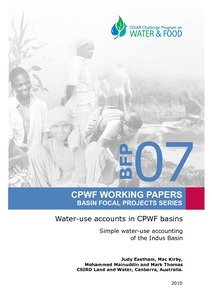Resource information
This paper applies the principles of water-use accounts, developed in the first of the
series, to the Indus River basin in South Asia. The Indus Basin covers 3 countries, rises
in the Tibetan plateau in the vicinity of Lake Mansarovar in China. Irrigated agriculture
in the Basin is extensive with the construction of dams, barrages, and link canals to
distribute water, with modern engineering to support irrigation starting as early as the
mid 1800s.
Net runoff is about 10% of total precipitation. Irrigated agriculture covers 20% of
the basin and use about 31% of the precipitation. Grassland is the most extensive
vegetation, covering 45% of the Basin, consuming about 36% of the precipitation.
Rainfed agriculture covers 14% of the Basin and uses about 15% of the water.
Changing irrigation efficiency from the currently assumed 40% to 60% and increasing
the irrigated area by 10% has relatively little impact on water availability overall, since
the water thus made available can be consumed downstream.
Keywords: Water use accounts, Indus basin, top-down modeling, basin water use.


